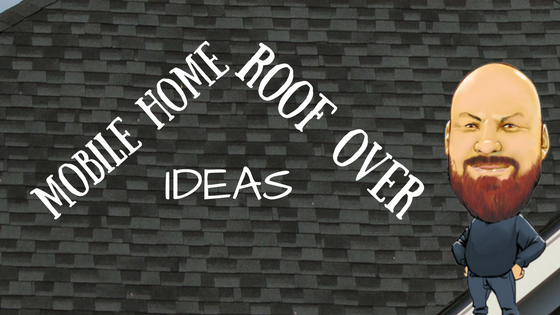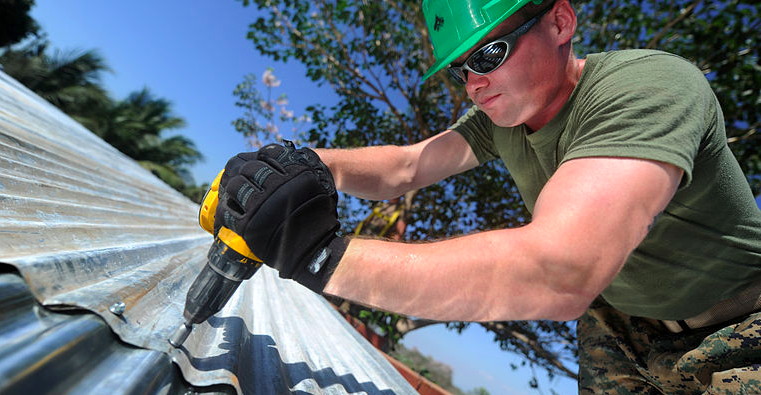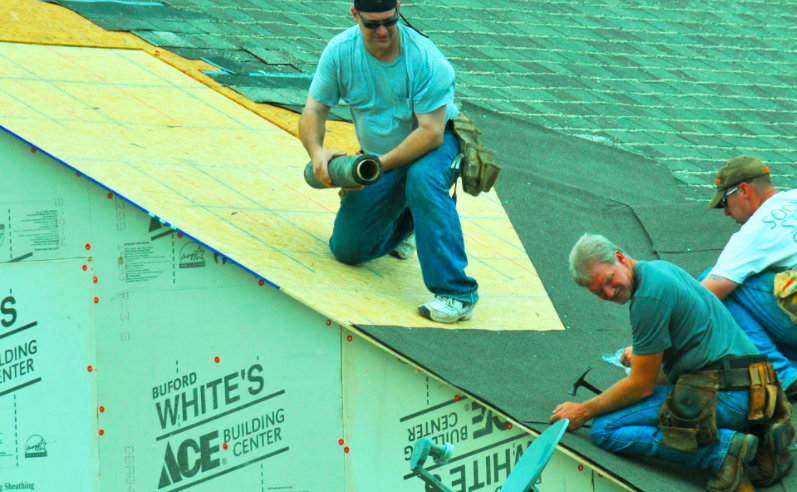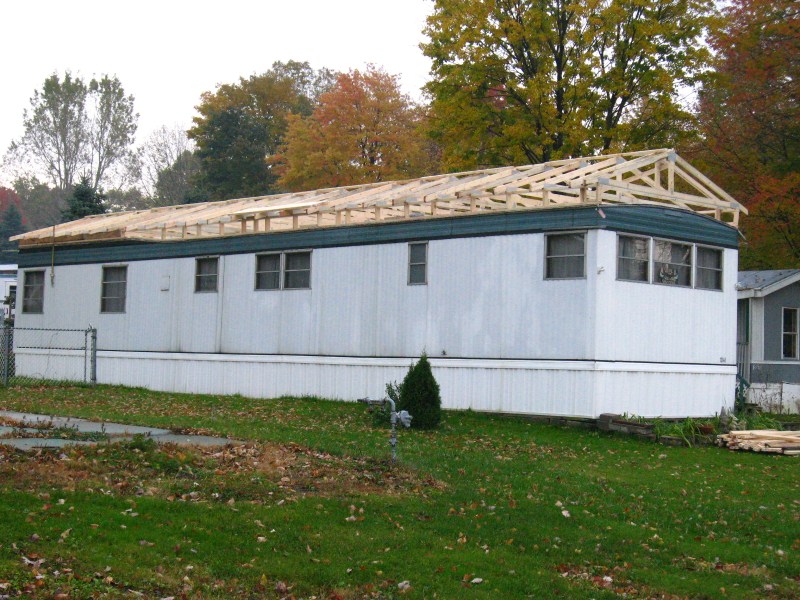Mobile Home Roof Over Ideas | A Great Upgrade To Your Home
There are quite a few reasons that the term “having a roof over your head” is so common. A roof might just be the most important part of any home. It is the one thing that protects all the other parts of your home as well as everything inside.
For mobile home owners there are two options if you want to repair or improve your roof: completely replace your roof or do a mobile home roof over. There are many different reasons why an owner would want to attempt either of these options, drastic as they sound:
- To stop leaks or water damage.
- To change the look of a home by turning a flat roof into a pitched one.
- Improve energy efficiency in winter and summer.
- Extra stability and fortitude to your roof.
- Depending on the type of roof over your roof might also make less noise.
These are just some of the reasons. We will expand and explain these later on when we come to roof over materials.
In this article, we will focus on mobile home roof overs. A “roof over” is the process of placing a new roof or roof material over your existing roof. Usually, you do not remove any part of the original roof, which not only saves money but shortens the process and is a less unsettling process. This is also an excellent opportunity to update the look and feel of your mobile home, which can also drive up it is value.
Roof over vs. Replace the roof
You might be wondering whether it is not better to simply tear off the old roof and replace it with a new one. This is an entirely viable option. The breakdown below shows the differences between replacing your roof and doing a “roof over”:
| Replace roof | Roof over |
| Completely takes care of any leaks or damage your roof developed over time. | Any underlying leaks or damage that are not fixed might become impossible to fix after. |
| There is no discernable rise in strain on your home. | The extra roof layer (sometimes a second roof is literally installed on top of the original) adds extra weight to the structure of your home. |
| You have to hire a professional to do the replacement. | A roof over can be done as a DIY project if you have some DIY or carpenter skills. |
| The initial cost of replacing the roof could be very high. | It can be affordable depending on the method. A roof over is definitely cheaper than a replacement |
Both options have their merits. A roof over is attractive to mobile home owners because you can do it yourself and it will cost much less.
However, if you do go the roof over the route, you must first inspect and repair any damage to your existing roof. If you do not, you might be forced later to do a roof replacement regardless. We will go into this in depth later, but it is frowned upon to roof over asphalt shingles (especially with new asphalt shingles). If you have asphalt shingles, the better option for you might be just to replace the roof.
Advantages of Mobile Home Roof Overs
1. Flat roof vs. Pitched roof
Mobile homes with flat roofs were once popular. However, more and more manufacturers are designing homes with pitched roofs, and homeowners themselves have turned to pitched roofs. What’s wrong with flat roofs you might ask? The two primary reasons:
- First, flat roofs require more recoating and maintenance than pitched roofs. Extra maintenance is needed because flat roofs are under more strain from weather and the elements.
- Second, there is a serious lack of drainage on flat roofs. As you can imagine the water has no angle to run off, so water tends to puddle. This leads to leaks or material breakdown, especially at corners and on the walls.
Nowadays pitched roofs are more in style than flat roofs. Installing a pitched roof will almost certainly modernize and improve the look of your home. It also breaks up the “boxiness” of mobile homes.
Since flat roofs need more maintenance and are more prone to leaks, you will need to make sure to fix all leaks and issues before installing a pitched roof over the flat roof.
2. Weather resistance
As we just covered, flat roofs are much less weather resistant than pitched roofs. Also after a while, all roofs come under strain. Every kind of roof material will eventually fail, which is when breakdown and leaks appear.
Asphalt roofs are even more prone to this than other types like PTO, metal or rubber roofs. They also need to be repaired by a trained professional. Corrugated steel roofs can also become rusted or have leaky seams, especially on flat roofs.
Doing a roof over adds an extra layer of protection above the original. Take note, it is critical that you repair any previous leaks or damage before doing a “roof over.” If you do not fix the current issues, water can get trapped between the two roofs and then the damage may get out of hand.

3. Temperature control and insulation
Whether you live in a non-HUD, pre-1976 mobile home or a newer one, roofs are the primary cause of energy loss because of their lower insulation. This can lead to excessive fuel consumption in winters especially if you live in one of the northern states. However, a simple mobile home roof over can help reduce heat loss, improve insulation and comfort, and enhance the appearance of the mobile home.
When you install a metal “roof over,” or turn your flat roof into a pitched roof, a great benefit is that it also adds a layer of insulation for your mobile home. This will make your home much more temperature efficient, and you can save a lot on utilities. Insulation materials are also usually cheap.
Except for adding insulation to control the temperature, most “roof over” materials are designed to reflect sunlight. The material’s reflective properties help keep the temperature down if your home is in a hotter climate.
Ways to roof over your mobile home
Before we delve into how to do a roof over let’s first cover 3 very common materials that mobile home “roof overs” use.
Roof over materials
1. Metal/Aluminium roof
Aluminum is the most popular type of “roof over” for mobile home users and with good reason. Here are the advantages to installing a metal roof over:
- You don’t have to do any work or remove any parts on the original roof. Many companies even provide a handy metal “roof over” kit that you can install yourself or leave to the contractor. Just remember that any previous leaks or damage still needs to be repaired beforehand.
- Since there is no work required on the original roof this installation allows you to be more in control of your budget when attempting a roof over.
- Most metal roof kits come with a warranty of either 40-60 years or the lifespan of your mobile home. That’s a whole lot of peace of mind! It also means that there is virtually zero maintenance needed by you.
- It is very easy to add insulation between the metal roof and the original roof, and the added insulation usually comes as a packaged deal with the installation.
- As mentioned earlier, like most roof overs it improves your roof’s insulation, weather resistance, sound blocking and appearance. This saves you money on utilities and maintenance.
- Metal roofs can also improve the value of your mobile home while potentially lowering your insurance premium.
Metal roofs come with enormous benefits and no minimal downsides. The only possible downside for some is a higher upfront cost. Metal roofs average around $1000-$2000 for a single-wide or $1800-$3000 for a double-wide. You can expect at least double that for a product that includes insulation.
PERMA-ROOF is a very reputable supplier that many mobile home owners swear by.
2. Asphalt shingles
Asphalt shingles have a bit of a bad rep. Look up “roof over” articles and blogs, and you will see more complaints and warnings than accolades. Here are some of those reasons:
- As you can imagine from such an overlapping and scale-like roof over, asphalt shingles are not the most watertight. Water damage is fairly common for these roofs, and they need to be regularly inspected.
- Asphalt shingles are pretty heavy. If you already have an asphalt roof, a second layer already adds significant weight to your home. A third layer is almost impossible.
- The lifespan of asphalt shingles is considered uncertain by many.
- Some suppliers give good warranties, but the lifespan is tightly bound to the owner’s commitment to maintenance and being aware of the local weather.
It is not all gloom and doom though, here are some pros for asphalt roofs:
- Asphalt is a very established product that contractors are comfortable using.
- An asphalt roof is very cheap to install. Depending on various factors like color, design, etc. You can pay anywhere from $700-$2000 for single-wides or $1200-$4000 for double-wides.
- It is very easy to install and should not take more than a day. It is recommended to use a contractor for warranty reasons.
- They can be particularly attractive if you choose the right design.
3. PTO or rubber membrane roof over
Firestone defines TPO as:
“Thermoplastic Polyolefin (TPO) is a single-ply reflective roofing membrane made from polypropylene and ethylene-propylene rubber polymerized together. It is typically installed in a fully adhered or mechanically attached system, allowing the white membrane to remain exposed throughout the life of the roof.”
It is simply a reflective mat that can be rolled and applied directly to your roof, or onto a frame fitted on top of the original roof. They are suitable for flat or pitched roofs. Here are some advantages of TPO roof overs:
- It is not too expensive. Prices range wildly, especially since you can also look at rubber (usually cheaper) or PVC (usually more expensive) options. The costs should run in between the previous two roof over types.
- Most materials rely on being white for a lot of their heat reflecting properties. TPO membranes come in gray or black options too, but with the same effectiveness. TPO membranes are also made to fit into the style of your home.
- These membranes are also resistant to mold growth, dirt accumulation, tears impact and punctures. Their flexibility also allows them to adapt to the way your mobile home has settled.
- As you can imagine from a membrane, you simply roll and stick to your roof they are very easy to install.
- They are also highly energy efficient.
Here are some disadvantages to TPO:
- TPO is a fairly young product. So, manufacturers are still trying to achieve the best chemical formula, and we are still coming to terms with the longevity of TPO.
- There have been questions surrounding how TPO membranes handle heat overloading in hot and sunny areas. When roofs reach 160 degrees, they seem to weather much sooner.
EPDM and thermoplastic roofing are similar alternative options. Here is a supplier for them.
How to tackle a mobile home roof over
The idea of adding a roof to your home can be daunting. Don’t worry, the process is often much simpler than it seems, and if you are not comfortable doing it, there are always the professionals.
Initial Roofing Stages
Step 1: The most important part of any roof over is to first come to terms with the state of your roof. Use the guide we provided earlier to check for any damage thoroughly. Typical signs your room has leaks or damage include:
- Sagging or Bowing (of ceiling, walls, gutters, siding, etc)
- Dark spots on Ceiling or Walls
- Peeling Wallpaper or Paint
- Light Showing through Cracks
If you have some roofing and/or carpentering experience, then you might be able to fix these yourself, else call an expert.
Step 2: Once your roof is back in tip-top condition, you can start looking at the various “roof over” options. Keep in mind that you can either buy the materials/kit and do it yourself, or you can pay a contractor to do it. We know you are probably on a budget, but you do not want to mess up your homes roof, so if you are not comfortable with this kind of work, please hire a professional.
Step 3: The method of installation varies wildly between different types of “roof overs,” and it is impossible to cover all methods here. Kits come with installation instructions. If you are dedicated and have some help a roof over should only take a full day. So just prepare for the inconvenience. Also, check the weather the day before and only attempt it on a sunny day.
** Keep in mind that a key piece in installing the roof over is calculating the area needed to be covered and determining the materials needed. The frame has to be installed first before the insulation and the new roof is laid over it. By ensuring that the roof over provides adequate overhang, it is possible to ensure that the windows and walls of the mobile home are protected from extreme weather.
Step 4: As part of your roof over you might also want to take advantage of the situation and find some roof paint (if your material allows) and do a repaint. You can also use roof cooling paints like Kool Seal for extra protection.
A Normal Looking Mobile Home Roof Over
A roof over can be installed over the existing roof of the mobile home – whatever its shape, flat, sloping, or domed. The roof over provides a new look to the mobile home making it look more like a site built home.
It is not very expensive to build a roof over that also includes insulation as you can find most of the materials needed at local hardware stores. Those with carpentry skills can complete the task on their own or retain the services of expert workmen.
Conclusion
While a roof over will provide insulation and reduce your heating costs, it also adds to the external, visual appeal of your home. Additionally, the roof over provides an extra barrier to ensure that water does not enter your home through the roof or walls.
A roof over soon pays for itself since it reduces your heating costs and protects the exterior and interior of your mobile home. This means that the mobile home is not impacted by extreme heat or rain and stays strong for a longer period of time.
By installing gutters and gutter spouts along the roof over of your mobile home and ensuring that rainwater drains away from your mobile home, you will also be able to divert any excess water from the peers and skirting. This type of roof, therefore, will reduce your maintenance expenses in the long term and also minimize the need for you to ever engage in a large home improvement undertaking to your mobile home.
Your Home Is Worth More
Manufactured home owners who are eager to improve their home and increase its value can benefit by undertaking a roof over project. As a roof is the primary protection for the rest of the structure and your family, a roof over can ensure that you have peaceful nights even when it rains or snows heavily. A roof over is an ideal mobile home improvement project that can be completed either by the owner if they have a certain level of home improvement skills or by a gifted carpenter. Material options continue to expand even as the standard options continue to rise. The cost may vary, so it is always good to get more than one quote.
There you go! That is almost all you need to know about mobile home roof overs. If done right it might be the only one you have to do in your home’s lifetime! That is a good investment, right?
*** Please note: We are not builders. The information found in this blog post is strictly for information only and should not be used as a template for a construction project. Please see the builder’s codes in your state or speak with a licensed contractor.







Trackbacks/Pingbacks